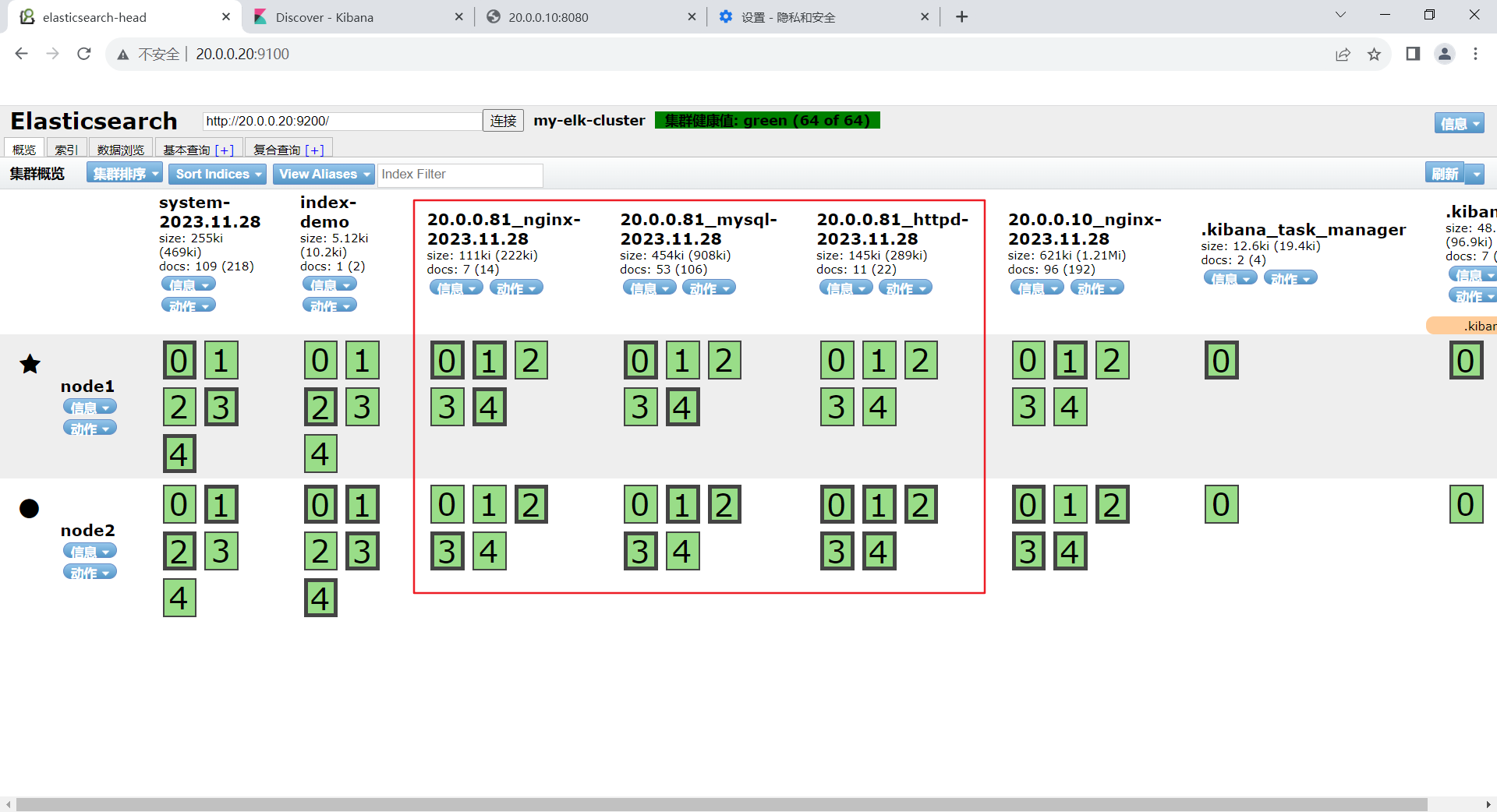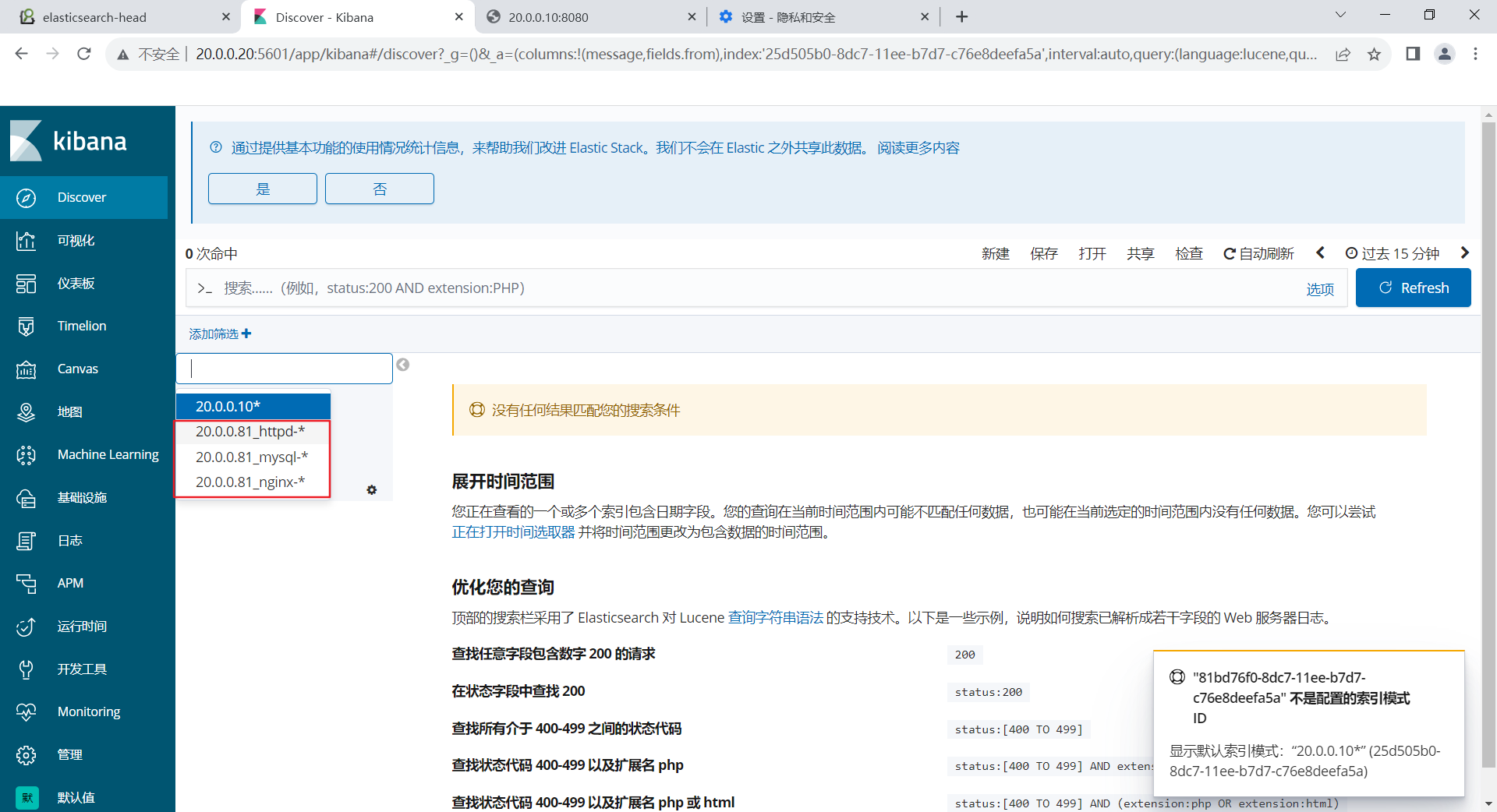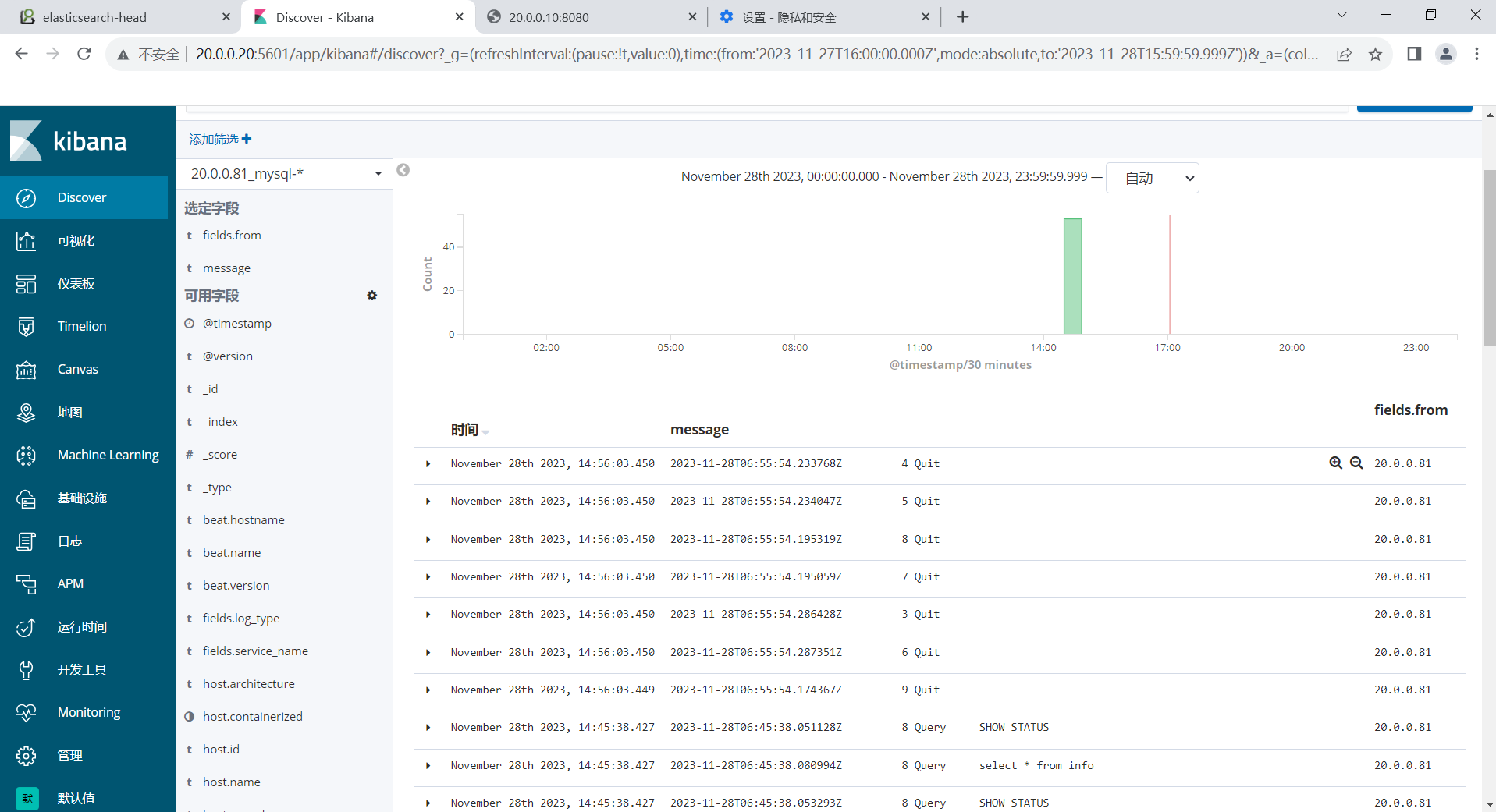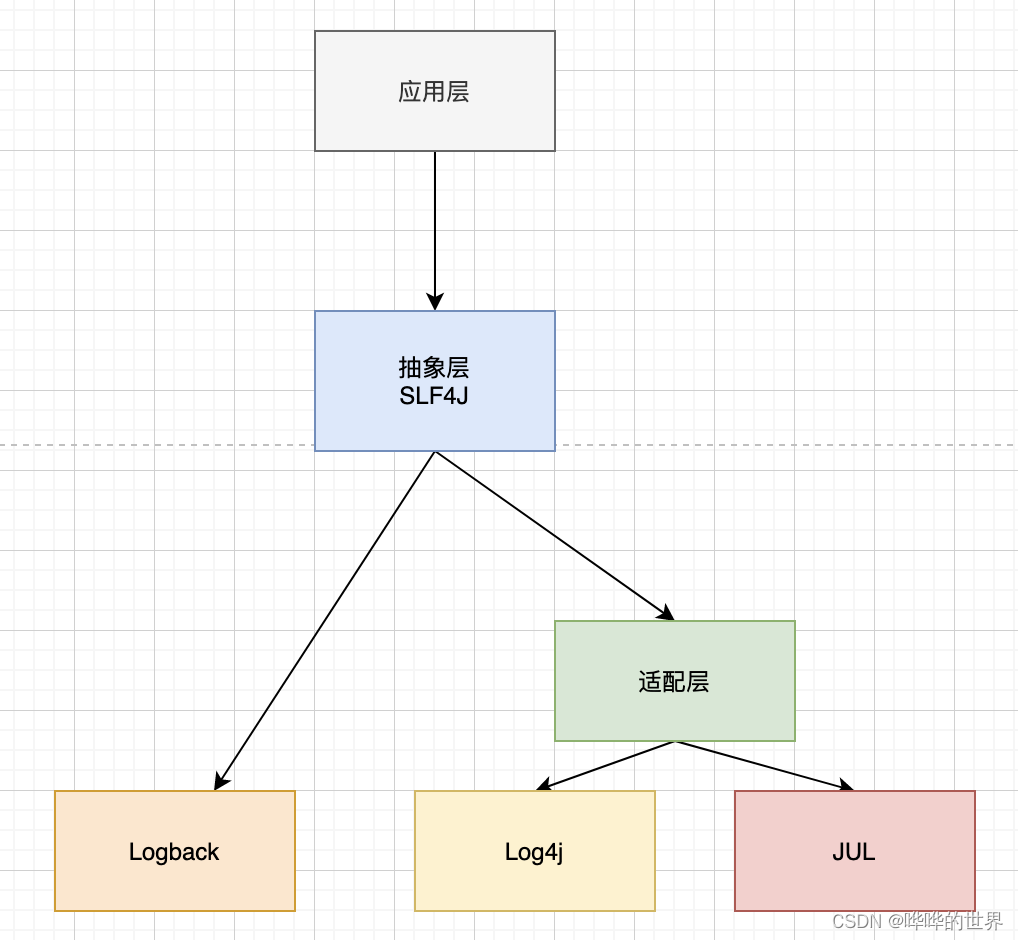本文介绍: Filebeat是一款轻量级的日志收集工具,可以在非JAVA环境下运行。因此,Filebeat常被用在非JAVAf的服务器上用于替代Logstash,收集日志信息。实际上,Filebeat几乎可以起到与Logstash相同的作用,可以将数据转发到Logstash、Redis或者是Elasticsearch中进行直接处理。因为logstash是jvm跑的,资源消耗比较大,启动一个logstash就需要消耗500M左右的内存(这就是为什么logstash启动特别慢的原因)。而filebeat只需要10M左右的
Filebeat概述
1.Filebeat简介
Filebeat是一款轻量级的日志收集工具,可以在非JAVA环境下运行。
因此,Filebeat常被用在非JAVAf的服务器上用于替代Logstash,收集日志信息。
实际上,Filebeat几乎可以起到与Logstash相同的作用,可以将数据转发到Logstash、Redis或者是Elasticsearch中进行直接处理。
2.使用Filebeat的原因
因为logstash是jvm跑的,资源消耗比较大,启动一个logstash就需要消耗500M左右的内存
(这就是为什么logstash启动特别慢的原因)。
而filebeat只需要10M左右的内存资源。
常用的ELK日志采集方案中,大部分的做法就是将所有节点的日志内容通过filebeat发送到logstash,lostash根据配置文件进行过滤,然后将过滤之后的文件传输到elasticsearch中,最后通过kibana展示。
3.Filebeat结合logstash的好处
Filebeat结合logstash中,Filebeat负责收集日志,logstash负责过滤
- 1、通过logstash,具有基于磁盘的自适应缓冲系统,该系统将吸收传入的吞吐量,从而减轻Elasticsearch持续写入数据的压力。
- 2、从其它数据源(例如数据库,s3对象存储或消息传递队列)中提取
- 3、将数据发送到多个目的地,例如S3,HDFS(hadoop分部署文件系统)或写入文件
- 4、使用数据流逻辑组成更复杂的处理管道。
本机直接收集日志实验
实验组件
Node1节点:node1/20.0.0.20 Elasticsearch
Node2节点:node2/20.0.0.30 Elasticsearch
Filebeat节点:20.0.0.10 Logstash Kibana Filebeat Nginx
实验步骤
1.安装Filebeat
#10
cd /opt/
--上传filebeat-6.7.2-linux-x86_64.tar.gz--
tar -xf filebeat-6.7.2-linux-x86_64.tar.gz
mv filebeat-6.7.2-linux-x86_64 filebeat
vim /etc/logstash/logstash.yml
--64--
path.config: /opt/log
systemctl restart logstash
2.时间同步
#所有节点
yum -y install ntpdate
ntpdate ntp.aliyun.com
date3.配置filebeat
#修改nginx的端口,防止与apache冲突
vim /etc/nginx/nginx.conf
...
listen 8080;
listen [::]:8080;
#给nginx日志文件赋权
cd /var/log/nginx/
chmod 777 access.log error.log
#配置filebeat
cd /usr/local/filebeat
vim filebeat.yml
filebeat.inputs:
- type: log
enabled: true
paths:
- /var/log/nginx/access.log
- /var/log/nginx/error.log
tags: ["nginx"]
fields:
service_name: 20.0.0.10_nginx
log_type: nginx
from: 20.0.0.10
--------------Elasticsearch output-------------------
(全部注释掉)
----------------Logstash output---------------------
output.logstash:
hosts: ["20.0.0.10:5044"] #指定logstash的IP和端口

4.配置logstash
cd /opt
mkdir log
cd log
vim file_nginx.conf
input {
beats { port => "5044"}
}
output {
if "nginx" in [tags] {
elasticsearch {
hosts => ["20.0.0.20:9200","20.0.0.30:9200"]
index => "%{[fields][service_name]}-%{+YYYY.MM.dd}"
}
}
stdout {
codec => rubydebug
}
}5.启动filebeat
nohup ./filebeat -e -c filebeat.yml > filebeat.out &
-------------------------------------------------------------------------------------------
nohup:表示在后台记录执行命令的过程
./filebeat:运行文件
-e:使用标准输出的同时禁用syslog文件输出
-c:指定配置文件
将执行过程输出到filebeat.out文件当中
&:后台运行
-------------------------------------------------------------------------------------------
logstash -f file_nginx.conf --path.data /opt/test1 &6.结果


远程收集多个日志实验
实验组件
logstash节点:20.0.0.10
Node1节点:node1/20.0.0.20 Elasticsearch
Node2节点:node2/20.0.0.30 Elasticsearch
日志来源服务器:20.0.0.81 MYsql Nginx Apache Filebeat实验步骤
1.安装Filebeat并配置
#81
cd /opt/
--上传filebeat-6.7.2-linux-x86_64.tar.gz--
tar -xf filebeat-6.7.2-linux-x86_64.tar.gz
mv filebeat-6.7.2-linux-x86_64 filebeat
cd filebeat/
vim filebeat.yml
filebeat.inputs:
- type: log
enabled: true
paths:
- /var/log/nginx/access.log
- /var/log/nginx/error.log
tags: ["nginx_81"]
fields:
service_name: 20.0.0.81_nginx
log_type: nginx
from: 20.0.0.81
- type: log
enabled: true
paths:
- /etc/httpd/logs/access_log
- /etc/httpd/logs/error_log
tags: ["httpd_81"]
fields:
service_name: 20.0.0.81_httpd
log_type: httpd
from: 20.0.0.81
- type: log
enabled: true
paths:
- /usr/local/mysql/data/mysql_general.log
tags: ["mysql_81"]
fields:
service_name: 20.0.0.81_mysql
log_type: mysql
from: 20.0.0.81
--------------Elasticsearch output-------------------
(全部注释掉)
----------------Logstash output---------------------
output.logstash:
hosts: ["20.0.0.10:5045"] #指定logstash的IP和端口2.配置logstash
10:
cd /opt/log/
vim nhm_81.conf
input {
beats { port => "5045"}
}
output {
if "nginx_81" in [tags] {
elasticsearch {
hosts => ["20.0.0.20:9200","20.0.0.30:9200"]
index => "%{[fields][service_name]}-%{+YYYY.MM.dd}"
}
}
if "httpd_81" in [tags] {
elasticsearch {
hosts => ["20.0.0.20:9200","20.0.0.30:9200"]
index => "%{[fields][service_name]}-%{+YYYY.MM.dd}"
}
}
if "mysql_81" in [tags] {
elasticsearch {
hosts => ["20.0.0.20:9200","20.0.0.30:9200"]
index => "%{[fields][service_name]}-%{+YYYY.MM.dd}"
}
}
stdout {
codec => rubydebug
}
}3.启动filebeat
nohup ./filebeat -e -c filebeat.yml > filebeat.out &
logstash -f nhm_81.conf --path.data /opt/test2 &4.结果



原文地址:https://blog.csdn.net/pupcarrot/article/details/134662777
本文来自互联网用户投稿,该文观点仅代表作者本人,不代表本站立场。本站仅提供信息存储空间服务,不拥有所有权,不承担相关法律责任。
如若转载,请注明出处:http://www.7code.cn/show_4973.html
如若内容造成侵权/违法违规/事实不符,请联系代码007邮箱:suwngjj01@126.com进行投诉反馈,一经查实,立即删除!
主题授权提示:请在后台主题设置-主题授权-激活主题的正版授权,授权购买:RiTheme官网
声明:本站所有文章,如无特殊说明或标注,均为本站原创发布。任何个人或组织,在未征得本站同意时,禁止复制、盗用、采集、发布本站内容到任何网站、书籍等各类媒体平台。如若本站内容侵犯了原著者的合法权益,可联系我们进行处理。






